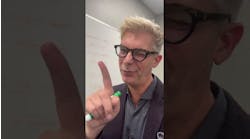By Vicki Cheeseman, Associate EditorDentistryIQ recently had the opportunity to interview Dr. Jeremy Mao, professor and director of the Tissue Engineering and Regenerative Medicine Laboratory at Columbia University, about the importance of stem cells in dentistry. The First International Conference on Dental and Craniofacial Stem Cells, which convenes in April, sets the stage for advancing the knowledge base in regenerative technologies.DentistryIQ: You hear so much about stem cells in the news. What is it about stem cells that warrant so much attention?Dr. Jeremy Mao: The interest in stem cells is based on their unique characteristics. Stem cells are master cells in the body that can transform into many types of cells that form nerves, bone, teeth, cartilage, and muscle, for example. Some of the unique characteristics of stem cells are the basis for the field of regenerative medicine, which uses the body’s own ability to maintain and repair itself to treat diseases, trauma, and tumor resection defects. Scientists are breaking new ground on a regular basis — developing therapies, growing organs, teeth, and bone using stem cell solutions. Equally important, a tremendous amount of research and trials are taking place that could potentially treat or cure diseases such as Parkinson’s, muscular dystrophy, diabetes, and more. “I believe in this,” Naidelys Montoya recently said. “I did as a precaution against things that could happen in the future” (click here to read article).DentistryIQ: Within dentistry and among consumers, there is a rising awareness of dental stem cells. What are the characteristics of dental stem cells that make them so interesting?Dr. Jeremy Mao: Many factors make dental stem cells interesting. Chief among them is their “plasticity” — that is, the ability to differentiate into various types of tissue, such as bone, teeth, nerve, and muscle. They also have the capacity to expand rapidly and often, hence stem cells from teeth can be expanded in vitro to therapeutically relevant numbers. They can be retrieved noninvasively as an adjunct to an existing dental procedure. It is now possible to recover and cryopreserve dental stem cells for potential use in future regenerative therapies. DentistryIQ: Why is the First International Conference on Dental and Craniofacial Stem Cells important?Dr. Jeremy Mao: The ICDCSC is important because it is the first time that the world’s leading scientists will come together to share their knowledge on and explore the possibilities of dental and craniofacial stem cells. This international collaboration will set the stage for advancing the knowledge base — a critical step to creating breakthroughs in regenerative technologies. DentistryIQ: Can you give us some examples of the research that is taking place using dental stem cells?Dr. Jeremy Mao: Dental stem cells are being studied to grow teeth; they have been shown to regenerate muscle fibers; they have been differentiated into cells that resemble cardiomyocites; and in lab studies they have been successfully utilized for corneal repair. In the latest example of their plasticity, a team I led recently published a paper demonstrating dental stem cells’ ability to differentiate into dystrophin-producing muscle cells, which has implications for the study and treatment of muscular dystrophy. DentistryIQ: It would appear that dental stem cells have uses beyond the oral cavity. How do you see this impacting the patient/dentist relationship?Dr. Jeremy Mao: The patient and dentist relationship will change on several fronts. Dentistry will move from restorative to regenerative, as dental stem cells show their capability to regrow teeth, jawbone, and muscle tissue. In addition to being the person you go to for a root canal or cavity filling, the dentist will serve as a gateway to a wide variety of regenerative therapies.DentistryIQ: What are some of the stem cell-based biologic dental treatments you see becoming available in the near future?Dr. Jeremy Mao: Instead of turning to dentures or dental implants, I believe patients will be able to regrow damaged or missing teeth with their own dental stem cells. Regenerated teeth or tooth components would be a long-lasting alternative, whereas dental implants can fail and cannot change to mold to surrounding jawbone that undergoes changes over time.DentistryIQ: Dr. Mao, thank you for your time and insight.Click here to find out more about the First International Conference on Dental and Craniofacial Stem Cells.Jeremy J. Mao, DDS, PhD, is currently a professor and director of the Tissue Engineering and Regenerative Medicine Laboratory at Columbia University. Dr. Mao has published more than 100 scientific papers and book chapters in the area of tissue engineering, stem cells, and regenerative medicine. He currently serves on the editorial board of several scientific journals including Tissue Engineering, Journal of Biomedical Material Research, International Journal of Oral and Maxillofacial Surgery, and Journal of Dental Research. He has served as an associate editor of stem cells and development, as well as on the editorial board of Medical Engineering and Physics and Frontiers of Bioscience. Dr. Mao is the editor of a new book, “Translational Approaches in Tissue Engineering and Regenerative Medicine,” and the editor of an upcoming textbook, “Principles of Craniofacial Growth and Development.” He is currently a standing member of the Musculoskeletal Tissue Engineering Study Section of the National Institutes of Health and serves on a number of review panels for NIH, NSF, U.S. Army, as well as many other grant review panels in more than 18 different countries. Dr. Mao has been invited to give lectures at more than 130 national and international conferences. He has also organized and chaired a number of scientific conferences, including the NIH-sponsored Stem Cells and Tissue Engineering Conference. Dr. Mao’s laboratory is currently funded by several research grants from the National Institutes of Health and also from industry. He is a consultant to Tissue Engineering and Regenerative Medicine Centers in the United States and overseas.
Latest
Latest





